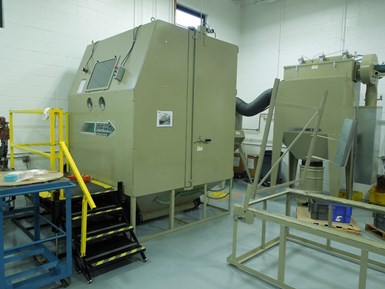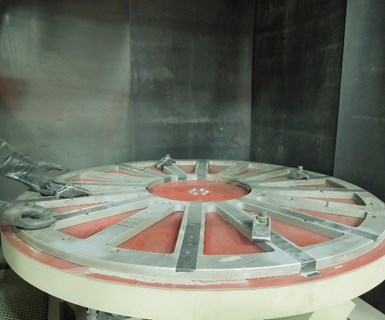Clemco Delivers Modified Abrasive Blasting Cabinet to MB Aerospace
Clemco supplied MB Aerospace with a modified abrasive blasting cabinet that allows for faster, onsite parts cleaning.
Earlier this year, Clemco Industries Corp. (Washington, Missouri) delivered a modified Zero BNP-7212 Suction Blast Cabinet to MB Aerospace’s facility in East Granby, Connecticut. MB Aerospace specializes in the manufacture and repair of aero-engine components. It has five facilities in Europe and one in Asia along with three U.S. locations.
“This cabinet will be our repair shop’s primary method for cleaning parts from the field,” says Timothy Clark, MB Aerospace senior manufacturing engineer. “We overhaul ground turbine components in this area of the shop, but first we have to clean engine residue, scaling, oil, etc., off the parts so that we can inspect for cracks and other wear issues.”

MB Aerospace uses its modified Zero BNP-7212 abrasive blasting cabinet to clean ground turbine components before inspecting them for cracks and wear.
More than 160 welders, fabricators and technicians work in the shop and factory. “The guys were immediately impressed when the cabinet arrived,” Clark recalls. “First off, it’s a monster. Basically a 7-foot cube for a work chamber. But after inspecting the cabinet and using it, people have all commented on how impressed they are with the quality of the welds and the workmanship in the cabinet, and the high-quality material used to construct it. The cabinet is operating exactly as intended.”
This modified BNP-7212 is fitted with a 66-inch rotating turntable that tilts at 30° and 45° angles for pinpoint blasting. The cabinet also is equipped with a 1200 CFM reverse-pulse dust collector and a 1200 CFM reclaimer.

The turntable tilts at 30° and 45° angles for pinpoint abrasive blasting.
The components that MB Aerospace blasts with the cabinet range in diameter from 36 inches to 72 inches, and in weight from 150 pounds to 350 pounds. Before receiving the cabinet, MB Aerospace sent parts out for cleaning with a typical turnaround of about one week.
“This morning, we cleaned a part in only three hours,” Clark says. “This included setup and shutdown of the cabinet, loading and unloading the part, and a wash cycle after the blasting. This is a huge time saver for us — from one week to a handful of hours. It helps us control our own destiny by using fewer outside vendors and working more in house.”
Related Content
-
AkzoNobel Uses VR for Training Airline Apprentices
The virtual reality technology provides a paint booth and spray gun that enables trainees to work and master their skills without losing parts in the process.
-
PPG, Satys Partner for Aerospace Ecoat System in France
PPG is partnering with Satys, a French industrial group active in aircraft sealing, painting and surface treatment.
-
Top Shop Emphasizes Dedication, Work Ethic
With a primary focus on aerospace and defense work, American Metaseal Corp. of Arbutus, Maryland, has qualified as a Top Shop on multiple occasions.

.JPG;width=70;height=70;mode=crop)











.jpg;maxWidth=300;quality=90)


